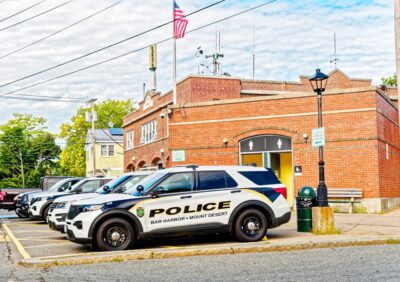
Criminal Rehabilitation and Justice in Maine
The following sections summarize crime data, criminal justice methods, prison information, incarceration rates, recidivism, and alternatives to incarceration in Maine.
Maine Prison Population Data
How many people are incarcerated in Maine? What are the biggest prisons in Maine? Answering these questions at the onset will give interested parties a direct view into the approach to criminal justice in Maine.
According to the Bureau of Justice Assistance, Maine has the second-lowest incarceration rate in the nation, after Massachusetts but ahead of Rhode Island. That means incarceration is usually only utilized as a last resort for offenders in Maine, even for violent offenders.1
The National Institute of Corrections (NIC) reports Maine has 13 jails in 16 counties.2 The jail population in 2019 was 1,710. Maine has six state prisons which hold 2,185 inmates. Maine’s incarceration facilities operate on a budget of $190,489,256 per year. According to the Urban Institute, Maine’s Department of Corrections is the 7th costliest item in the state’s annual budget.3
Maine incarcerates just 146 people for every 100,000 living in the state. For comparison, the U.S. incarcerates 358 per 100,000, and Mississippi, the state with the highest incarceration rate, incarcerates 584 people for every 100,000 living in the state. Maine also has a community corrections system with 6,568 people under probation and 19 under parole.
It’s worth mentioning that while Maine only incarcerates 146 for every 100,000 residents, the state’s violent crime rate is higher than the incarceration rate. That’s because Maine utilizes several incarceration alternatives to address wrongdoing without exposing offenders to prison. While Maine spent much of the late 20th and early 21st century with a rising jail and prison population rate, both rates began to decline following criminal justice reform between 2008 and 2014.

Located in Warren, Maine, the Maine State Prison was originally erected in Thomaston, Maine in 1824 and was then relocated to Warren in 2002. As the largest prison in Maine, the maximum-security prison has a capacity of 916 adult male inmates and maintains an average daily population of 900. As an interesting bit of trivia, the Thomaston prison served as Stephen King’s inspiration and basis for his famous novella Rita Hayworth and Shawshank Redemption.4
Maine used to contract with private prisons, but the state has since moved away from this practice. Between 2000 and 2020, Maine ended all of its contracts with private prisons, and there are now zero Maine inmates residing in private prisons. Maine does not host any federal prisons or federal prison camps.
Crime Rates in Maine
According to the Maine State Police, Maine’s violent crime rate is much lower than the national average. Maine recorded just 22 murders in 2020, or 1.6 murders for every 100,000, the second-lowest murder rate in the nation.5
And it’s not just the murder rate that is especially low in Maine. The state also has low rates of rape, robbery, and aggravated assault. In 2020, Maine recorded 109 violent crimes for every 100,000 people living in the state, compared to 399 per 100,000 nationwide.
Perhaps most importantly, Maine’s crime rates have been gradually trending downward. Total crime decreased by 6.1% in 2020, and violent crime dropped by 4.9%. This is surprising given that crime rates increased for most of the nation during the Covid-19 pandemic.
Maine Recidivism

Perhaps the most crucial metric to judge a state’s criminal justice system is the state’s statistical data on recidivism. What is Maine’s recidivism rate? According to one federal report, about 22.4% of Mainers released from prison will re-offend and become incarcerated again.6
Just as with the crime rates, the state’s reporting on recidivism shows a lower figure than the federal data. According to the Maine Department of Corrections, only about 10%-14% of Maine offenders will re-offend after being released from prison. If that data is accurate, it means Maine has one of the lowest recidivism rates in the nation.7
Criminal Reform and Alternatives to Incarceration in Maine
Maine has the second-lowest incarceration rate in the nation and one of the lowest violent crime rates and recidivism rates. Several factors contribute to this. The state has a very small population (just 1.338 million people) and an even lower population density (41.3 people per square mile). Also, Maine has a much older population than most states, with the average median age in Maine being 44.7 years old. Crime, especially violent crime, is usually committed by younger people.
When asked to compare Maine’s crime rate to California’s and to explain why Maine’s crime rate is so much lower, Forward Planning’s former director Carlos Yanez put it rather humorously, “So California has 3 times the crime rate but 30 times the population and 6 times the density. What this means is that if you want to commit a crime in Maine, you need to first put on your thermals, a wool sweater, parka, mud boots, scarf, earmuff, wool hat, gloves, and then go search for someone. Moose don’t count. In California just turn around.”7
But beyond a low, rural, homogenous, and aging population, what is Maine doing on the policy level that has led to low crime rates, incarceration, and recidivism?
For one, Maine has been committed to investing heavily in its law enforcement, especially in creating competent, trained, and experienced officers that can provide public safety and evolve as an institution that provides that safety. Public Safety Commissioner Michael Sauschuck highlighted this point of evolution of law enforcement: “Maine’s law enforcement professionals and our amazing community partners have delivered a ninth straight year of crime reduction and we truly thank you for your compassion and dedication to our residents. Our complex world was complicated further with ongoing covid related protocols and safety concerns, but you selflessly reported for duty. This is just the latest example of your willingness to evolve as a profession and I look forward to further enhancing our efforts to Protect and Serve.”
Maine has also instituted programs to end violent crime in the state, like the Maine Coalition Against Sexual Assault and the Maine Coalition to End Domestic Violence. Maine policymakers and crime reduction advocates are adamant that reducing crime in Maine may start with competent law enforcement, but it ends with having programs that provide real material assistance to residents. To that point, Francine Garland Stark, Executive Director of the Maine Coalition to End Domestic Violence, said, “The criminal justice system is an important component of our community’s safety net for adult and child victims of domestic violence, but it is essential that we recognize that effectively intervening and ending domestic violence requires a multi-layered and community-wide approach in which those who believe they can treat their intimate partners and families horribly will be convinced to change their beliefs and abusive behavior and that those they harm are supported to be safe and secure.”
“Alternatives to incarceration are feasible in Maine and they can be demonstrably less expensive than institutionalization of offenders.”
Further, Maine provides several alternatives to incarceration for offenders, seeking to only use incarceration as a last resort for Mainers who break the law. Alternatives to incarceration in Maine have proven to be quite effective and affordable in the state, with one federal examination of Maine’s alternative programs concluding: “Alternatives to incarceration are feasible in Maine and they can be demonstrably less expensive than institutionalization of offenders.” Such programs include work-release programs, drug and alcohol rehabilitation programs, community service commitments, home confinement, and probation.9
Criminal reform in Maine is working better than in many states, but it is still not perfect. For example, Maine’s Domestic Violence Resource Centers provided critical assistance to more than 11,000 adults in crisis in 2021. While this is a good program and should be replicated in other states, incoming calls from survivors were up 13% in Maine in 2021, suggesting a growing problem of domestic violence in the state.
Looking to the future, criminal rehabilitation in Maine and the overall criminal justice system in Maine will have to implement new, evidence-based programs to help offenders get to the bottom of why they committed crimes in the first place. Educational programs inside prisons in Maine and rehabilitation programs inside prisons in Maine may be the answer to creating one of the nation’s best criminal justice systems, potentially a model for other states to follow.
We can achieve a crime-free society, and Maine is much closer to it than many other regions of the United States. With a few reforms, educational programs, and truly beneficial rehabilitative modalities, Maine could perhaps create a blueprint for a more human-focused, reform-based approach to crime and criminal justice.
Sources Cited:
- BJS. “Prisoners in 2020 – Statistical Tables.” Bureau of Justice Statistics, 2021. bjs.ojp.gov
- NIC. “Maine 2019.” National Institute of Corrections, 2019. nicic.gov
- Urban. “Project Maine.” Urban Institute, 2022. urban.org
- NewsCenterMaine. “25 years ago, King’s ‘Shawshank Redemption’ hit the big screen.” News Center Maine, 2019. newscentermaine.com
- MSP. “Crime continues to decrease in Maine for 9th consecutive year.” Department of Public Safety, Maine State Police, 2021. maine.gov
- BJA. “Criminal Justice Profile: Maine.” Bureau of Justice Assistance, 2014. bjafactsheets.iir.com
- DOC. “Return to Custody Report One Year Post Release 2010–2019.” Maine Department of Corrections, 2020. maine.gov
- Quora. “Why do states like Maine have low crime and states like California have high crime?” Quora, 2019. quora.com
- DOJ. “Cost – Benefit Analysis of Alternatives to Incarceration in Maine.” U.S. Department of Justice Office of Justice Programs, 1977. ojp.gov
Related Articles
Criminal Justice Reform Extends Rights to Felons Who Have Served Their Sentences
For decades, voter enfranchisement or disenfranchisement for incarcerated and formerly incarcerated individuals has been debated. An estimated 4.6 million Americans are barred from voting due...
Read more >>
Maine and Alaska, Two Similar States with Dramatically Different Violent Crime Rates
Every U.S. state has its approach to crime, incarceration, criminal justice, and public safety. Maine and Alaska share similarities in their demographics, environments, economies, rural...
Read more >>
Successful Parenting for Anyone
Parents are the first teachers of children. Most parents learn parenting skills from what their parents did (or didn’t do). Unfortunately, this is not always...
Read more >>
Breaking the Circle of Negative Behavior
The Way to Happiness Course Is the Key A section of the course that gave me greater insight was “Be Competent” – in particular, the...
Read more >>






